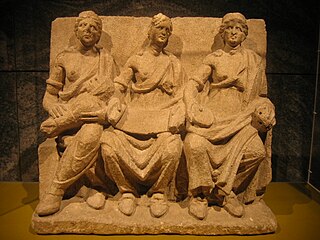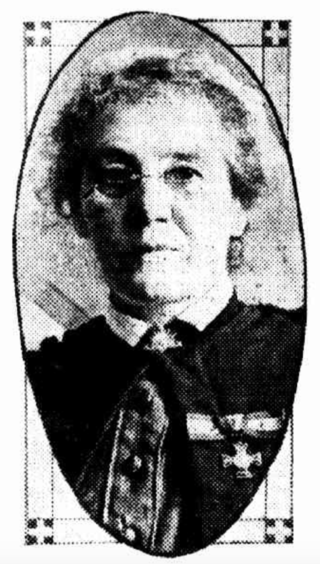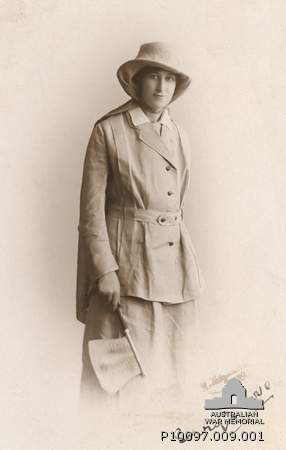
Modron ("mother") is a figure in Welsh tradition, known as the mother of the hero Mabon ap Modron. Both characters may have derived from earlier divine figures, in her case the Gaulish goddess Matrona. She may have been a prototype for Morgan le Fay from the Arthurian legend.

The Matres and Matronae were female deities venerated in Northwestern Europe, of whom relics are found dating from the first to the fifth century AD. They are depicted on votive offerings and altars that bear images of goddesses, depicted almost entirely in groups of three, that feature inscriptions and were venerated in regions of Germania, Eastern Gaul, and Northern Italy that were occupied by the Roman army from the first to the fifth century.

The stola was the traditional garment of Roman women, corresponding to the toga that was worn by men. It was also called vestis longa in Latin literary sources, pointing to its length.

The Royal London Hospital is a large teaching hospital in Whitechapel in the London Borough of Tower Hamlets. It is part of Barts Health NHS Trust. It provides district general hospital services for the City of London and Tower Hamlets and specialist tertiary care services for patients from across London and elsewhere. The current hospital building has 1248 beds and 34 wards. It opened in February 2012.
Pidgeon is a surname from an archaic spelling of pigeon.

Matron is the job title of a very senior or the chief nurse in several countries, including the United Kingdom, and other Commonwealth countries and former colonies.

Carry On Doctor is a 1967 British comedy film, the 15th in the series of 31 Carry On films (1958–1992). It is the second in the series to have a medical theme. Frankie Howerd makes the first of his two appearances in the film series and stars alongside regulars Sid James, Kenneth Williams, Jim Dale, Charles Hawtrey, Joan Sims, Peter Butterworth, and Bernard Bresslaw. Hattie Jacques returns for the first time since Carry On Cabby four years earlier, while Barbara Windsor returns after her debut in Carry On Spying three years earlier. Carry On Doctor marks Anita Harris's second and final appearance in the series. The film was followed by Carry On Up the Khyber in 1968.
Nursing in the United Kingdom is the largest health care profession in the country. It has evolved from assisting doctors to encompass a variety of professional roles. Over 700,000 nurses practice, working in settings such as hospitals, health centres, nursing homes, hospices, communities, military, prisons, and academia. Most are employed by the National Health Service (NHS).
Nursing management consists of the performance of the leadership functions of governance and decision-making within organizations employing nurses. It includes processes common to all management like planning, organizing, staffing, directing and controlling. It is common for registered nurses to seek additional education to earn a Master of Science in Nursing or Doctor of Nursing Practice to prepare for leadership roles within nursing. Management positions increasingly require candidates to hold an advanced degree in nursing.

Queen Alexandra's Royal Naval Nursing Service (QARNNS) is the nursing branch of the British Royal Navy. The Service unit works alongside the Royal Navy Medical Branch.

Doctor in Clover is a British comedy film released in 1966, starring Leslie Phillips. The film is based on the novel of the same title by Richard Gordon. It is the sixth of the seven films in the Doctor series.
Catherine Murray Roy, was a decorated Scottish military nurse who served at the front during the First World War. She was later Matron-in-Chief of Queen Alexandra's Imperial Military Nursing Service.
Mōdraniht or Modranicht was an event held at what is now Christmas Eve by Anglo-Saxon pagans. The event is solely attested by the medieval English historian Bede in his eighth-century Latin work De temporum ratione. It has been suggested that sacrifices may have occurred during this event. Scholars have proposed connections between the Anglo-Saxon Mōdraniht and events attested among other Germanic peoples, and the Germanic Matres and Matronae, female beings attested by way of altar and votive inscriptions, nearly always appearing in trios.

In Germanic mythology, an idis is a divine female being. Idis is cognate to Old High German itis and Old English ides, meaning 'well-respected and dignified woman.' Connections have been assumed or theorized between the idisi and the North Germanic dísir; female beings associated with fate, as well as the amended place name Idistaviso.

Harriet Maria Simpson was a New Zealand hospital matron, servants’ home matron and dressmaker.

Venus Verticordia was an epithet of the Roman goddess Venus, alluding to the goddess' ability to change hearts from lust to chastity.

Margaret Graham, RRC was a nurse at the centre of a dispute dubbed the "Adelaide Hospital Row" at the Adelaide Hospital in 1894. She overcame this dubious distinction to become the highly regarded matron of the hospital, then one of the first Australian nursing matrons to serve at the front during the First World War.

Christense Sorensen (1885–1958) was an Australian hospital matron and army nurse. She served during the First World War and later became a civilian matron. She held positions in the Australian Army Nursing Service, Brisbane General Hospital, and Rosemount Repatriation Hospital. Upon her retirement she had treated more than a million patients.












